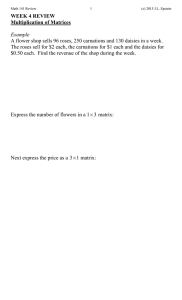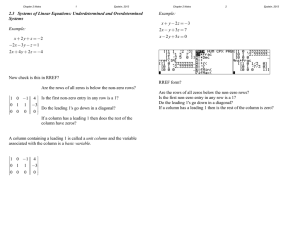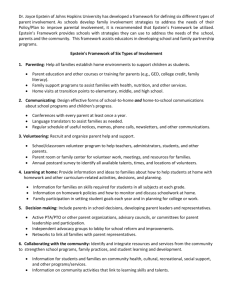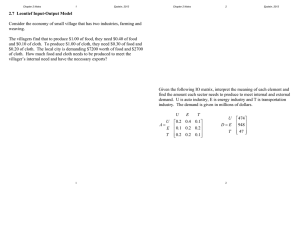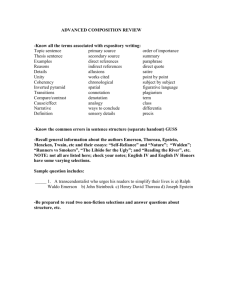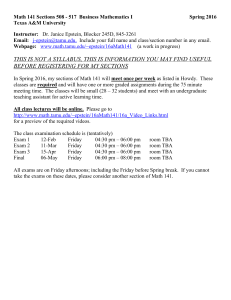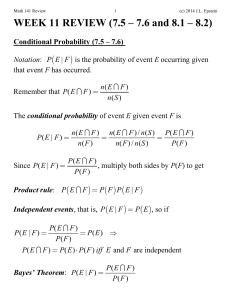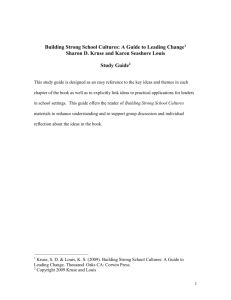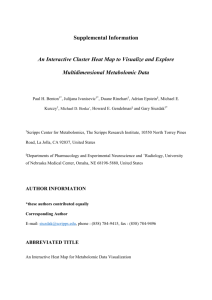Document 10393693
advertisement
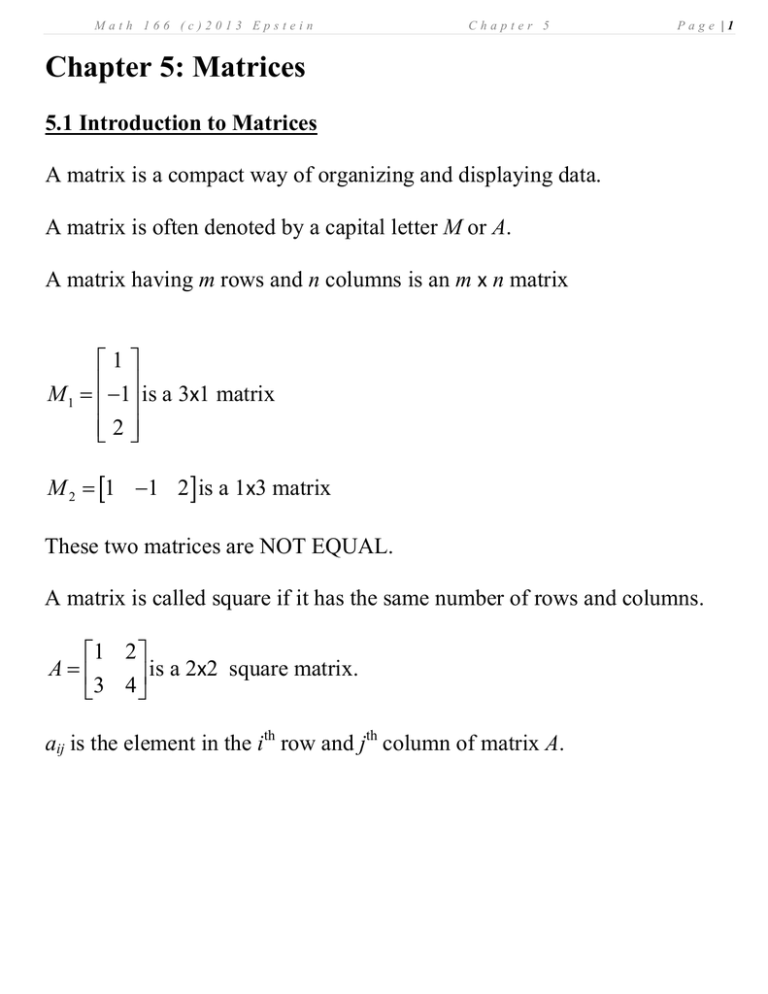
Math 166 (c)2013 Epstein Chapter 5 Page |1 Chapter 5: Matrices 5.1 Introduction to Matrices A matrix is a compact way of organizing and displaying data. A matrix is often denoted by a capital letter M or A. A matrix having m rows and n columns is an m x n matrix 1 M 1 1 is a 3x1 matrix 2 M 2 1 1 2 is a 1x3 matrix These two matrices are NOT EQUAL. A matrix is called square if it has the same number of rows and columns. 1 2 A is a 2x2 square matrix. 3 4 aij is the element in the ith row and jth column of matrix A. Math 166 (c)2013 Epstein Chapter 5 Page |2 Example - There are three stores. In the first week store I sold 88 loaves of bread, 48 quarts of milk, 16 jars of peanut butter and 112 pounds of cold cuts. At the same time, store II sold 105 loaves of bread, 72 quarts of milk, 21 jars of peanut butter and 147 pounds of cold cuts. Store III sold 60 loaves of bread, 40 quarts of milk, 0 jars of peanut butter and 50 pounds of cold cuts. Organize this data in a 3x4 matrix. Equality - two matrices are equal if and only if each pair of corresponding elements are equal. EXAMPLE Find the values of a, b, c, d given é1 bù é a -1ù ê ú=ê ú êë3 0úû êë c d úû Addition - two matrices are added by adding the pairs of elements in each location. é 2 -3ù é-0.25 7ù ê ú ê ú ê ú ê 0 5 and B = -3 1.5ú EXAMPLE find A+B where A = ê ú ê ú ê 0.25 ê 6úû 9 2úû ë ë Math 166 (c)2013 Epstein Chapter 5 Page |3 Transpose - The transpose of a matrix is found by switching the rows and columns of the matrix. If A is a 3x2 matrix then AT will be a 2x3 matrix. é 2 -3ù ê ú ê A= 0 5ú ê ú ê 0.25 6úû ë A scalar is a number (NOT a matrix). Multiply a matrix by a scalar by multiplying every element in the matrix by the scalar. EXAMPLE Find -2A. é 2 -3ù ê ú ê 0 5ú = -2 A = 2 ê ú ê 0.25 6úû ë Math 166 (c)2013 Epstein Chapter 5 Page |4 5.2 Matrices Multiplication Example A flower shop sells 96 roses, 250 carnations and 130 daisies in a week. The roses sell for $2 each, the carnations for $1 each and the daisies for $0.50 each. Find the revenue of the shop during the week. Express the number of flowers in a 1´ 3 matrix: Next express the price as a 3´1 matrix: Math 166 (c)2013 Epstein Chapter 5 Page |5 In general, if A is 1´ n and B is n´1 , the product AB is a 1´1 matrix: A ⋅ B = [ a11 a12 é b11 ù ê ú êb12 ú a1n ]⋅ ê ú = [ a11 ⋅ b11 + a12 ⋅ b21 + + a1n ⋅ bn1 ] êú ê ú êêb úú ë n1 û If A is an m ´ n matrix and B is a n ´ p matrix, then the product matrix A ⋅ B = C is an m ´ p matrix. é a11 a12 a1n ù é b11 b12 ê ú ê ê a21 a22 a2 n ú êb21 b22 ú⋅ê A⋅ B = ê ê ú êê ê ú êê a amn úúû êêëbn1 bn 2 ë m1 am 2 b1 p ù ú b2 p ú ú ú ú bnp úúû é a11 ⋅ b11 + a12 ⋅ b21 + + a1n ⋅ bn1 ( ab)12 ê ê (ab) 21 (ab) 22 ê =ê ê ê ( ab) m1 ( ab) m 2 êë (ab)1 p ù ú (ab) 2 p ú ú ú ú (ab) mp ûúú Matrix multiplication is not commutative. In general, AB ¹ BA Example Find the products AB and BA where é 1 0ù é-1 2 ù ú and B = ê ú A= ê êë-2 3úû êë 0 -3úû Math 166 (c)2013 Epstein Chapter 5 Page |6 Example - Cost Analysis - The Mundo Candy Company makes three types of chocolate candy: cheery cherry (cc), mucho mocha (mm) and almond delight (ad). The candy is produced in San Diego (SD), Mexico City (MC) and Managua (Ma) using two main ingredients, sugar (S) and chocolate (C). Each kilogram of cheery cherry requires 0.5 kg of sugar and 0.2 kg of chocolate. Each kilogram of mucho mocha requires 0.4 kg of sugar and 0.3 kg of chocolate. Each kilogram of almond delight requires 0.3 kg of sugar and 0.3 kg of chocolate. (a) Put this information in a 2x3 matrix. (b) The cost of 1 kg of sugar is $3 in San Diego, $2 in Mexico City and $1 in Managua. The cost of 1 kg of chocolate is $3 in San Diego, $3 in Mexico City and $4 in Managua. Put this information into a matrix in such a way that when it is multiplied by the matrix in part (a) it will tell us the cost of producing each kind of candy in each city. Math 166 (c)2013 Epstein Chapter 5 One special matrix is called the identity matrix, I. It is a square matrix with 1's on the diagonal and zeros elsewhere, é1 ê ê0 I=ê ê ê ê0 ë 0 1 0 0ù ú 0ú ú ú ú 1úû I2 is a 2 ´ 2 identity matrix and I n is an n ´ n identity matrix. The identity matrix has the following property Matrix multiplication and linear equations: Example Write the following system of linear equations as a matrix equation 2x 3y 6 x 2 y 4 Answer 2 3 x 6 1 2 y 4 Page |7 Math 166 (c)2013 Epstein Chapter 5 Page |8 5.3 Inverse of a Square Matrix For any non-zero real number r, the reciprocal (or inverse) is 1 or r 1 r Multiplicative identity: For matrices, the inverse is A-1 and it is defined by A matrix with no inverse is called singular. If needed, find the inverse with the x-1 function on the calculator. The one use of matrix inverses is to solve matrix equations. Solve the matrix equation AX = B for X Solve the matrix equation D = X – AX for X. Math 166 (c)2013 Epstein Chapter 5 Page |9 Matrix inverses can be used to encrypt messages. First, assign each letter of the alphabet a number: 1 to A 2 to B 8 to H 9 to I 15 to O 16 to P 22 to V 23 to W 3 to C 4 to D 5 to E 10 to J 11 to K 12 to L 17 to Q 18 to R 19 to S 24 to X 25 to Y 26 to Z 6 to F 7 to G 13 to M 14 to N 20 to T 21 to U 27 to space So the word aggies would be written To make this more difficult to decode, we can put the letters in a message matrix. Our encoding matrix will be 3x3, so our message will need to have 3 rows: M= And multiply by an encoding matrix E = EM = Decode the message, M = E-1 (EM) = Decode the message below using the encryption matrix E. 35 82 100 143 98 175 259 329 52 95 115 151 Math 166 (c)2013 Epstein Chapter 5 P a g e | 10 5.4 Additional Matrix Applications: Leontief Input-Output Models Consider the economy of small village that has two industries, farming and weaving. The villagers find that to produce $1.00 of food, they need $0.40 of food and $0.10 of cloth. To produce $1.00 of cloth, they need $0.30 of food and $0.20 of cloth. The local city is demanding $7200 worth of food and $2700 of cloth. How much food and cloth needs to be produced to meet the villager’s internal need and have the necessary exports? Math 166 (c)2013 Epstein Chapter 5 P a g e | 11 Given the following IO matrix, interpret the meaning of each element and find the amount each sector needs to produce to meet internal and external demand. U is auto industry, E is energy industry and T is transportation industry. The demand is given in thousands of dollars. U U A E T E T 0.2 0.4 0.1 0.1 0.2 0.2 0.2 0.2 0.1 U DE T 474 948 47 Math 166 (c)2013 Epstein Chapter 5 P a g e | 12 Closed Leontief Input-Output Model In the closed input-output model, we assume that there is no demand from outside the n industries under consideration. Let fij be the fraction of the total output of the jth industry purchased by the ith industry. The problem then is to find suitable prices for each of the n outputs so that the total expenditure of each industry equals its total income. Any such price structure represents equilibrium for the economy. Let pi be the price charged by the ith industry for its total output. For convenience, consider an isolated island with three sectors: farming, building and services. As usual, we allow for the possibility that each industry consumes (and therefore buys) some of its own product. To produce 1 unit from the farming sector it takes ½ unit of farming, 1/3 unit of building and 1/6 unit of services. To produce 1 unit of building requires 1/3 unit of farming, 1/3 unit of building, and 1/3 unit of services. To produce 1 unit of services requires ¼ unit of farming, ¼ unit of building and ½ units of services. What are the equilibrium prices for these three sectors?
